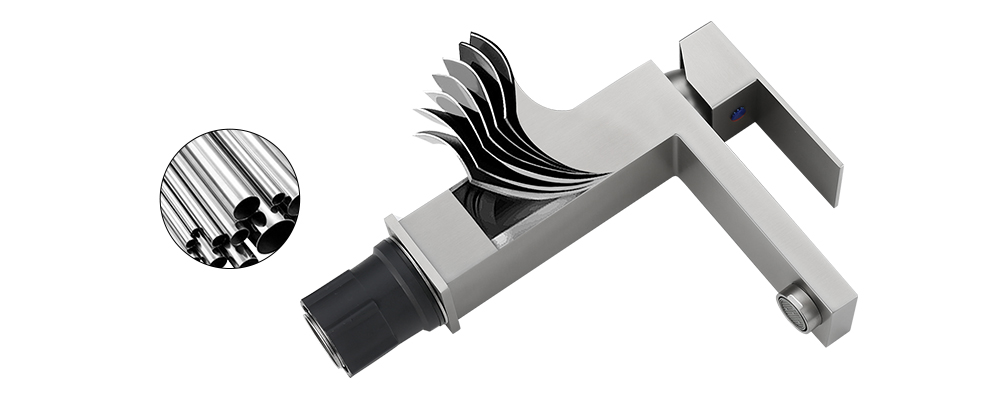Latuna Krano Vs Neoksidebla Ŝtalo Krano: Kio Estas La Diferenco?
Elekti la perfektan kranon por via hejmo povas esti superforta decido. Materialo, stilo funkcio, kaj prezo ĉiuj kombinas por fari vian elekton pli malfacila! Krom voli esti estetike plaĉa, la ĉefa graveco estas la kvalito kaj fortikeco de via krano.
Latuno kaj Neoksidebla ŝtalo estas la du ĉefaj fluoj de materialo uzata por krana aparataro sur la merkato. Ambaŭ elektoj estas ekstreme helpemaj kaj garantias vivdaŭron de uzo kaj feliĉo, sed kio estas la ĉefa kontrasto inter ili?
Materiala Komponado (La Teknikaj Aĵoj)
Latuno estas aloja metalo farita el plejparte kupro kaj zinko. La komponado povas varii ie ajn inter 50-63% kupro kaj 50-37% zinko, kun aliaj aldonaĵoj uzataj por materiala maleblo. Fabrikistoj uzas diversajn metodojn por krei latunan aparataron, inkluzive forĝita, forĝita, gisita, kaj tranĉitaj procezoj.
Ĉar ĝi havas relative malaltan frostopunkton, ĝi estas pli facila por gisi kaj estas sufiĉe mola por maŝinprilabori kun malmulte da fortostreĉo sed sufiĉe fortika por elteni la rigorojn de la vivo kiel krano.. Unu el la ĉefaj (kaj nur) problemoj kun latunaj kranoj estas ke ili ne estas 100% senplumbo. En la pasinteco, plumbo estis aldonita al latuno por fleksebleco, sed nun ĝi plejparte ne estas permesita en kranoj kaj akvotubaroj.
Antaŭe 2014, krano povus enhavi tiom kiom 8% gvidi kaj ankoraŭ nomas sin senplumbo. Nun la maksimuma plumboenhavo en krano estas 0.25% (1/4 de 1%). La hodiaŭa krano-latuno nun estas “senplumbo” plenumi limigojn, uzante malsamajn aldonaĵojn por fleksebleco anstataŭ plumbo.

latuna krano
Neoksidebla ŝtalo 304 kaj 316 estas alia materiala elekto uzata por kranoj. Ĉi tiuj neoksideblaj opcioj enhavas 18% kromo kaj 8-10% nikelo, la nikelo donanta al la ŝtalo apartan kristalan strukturon por pliigi la forton kaj maleblon de la materialo dum la kromo helpas la ŝtalon rezisti korodon..
Malgranda kvanto da molibdeno (2-3%) estas aldonita al 316 ŝtalo por pli bone rezisti acidojn. Ambaŭ materialoj estas aŭstenitaj ŝtaloj, kio signifas ke ili estas malaltaj- aŭ ne-magneta. Neoksidebla 304 estas senkompare la pli ofte uzata alojo por fabrikado de kranoj, el kio estas faritaj niaj Lulani neoksideblaj ŝtalaj kranoj.
Neoksidebla 316, konata kiel mara grado neoksidebla, havas superan reziston al pikado, korodo, kaj makulado, precipe en acidaj aŭ salaj medioj, sed venas sekundon malantaŭ Stainless 304 pro ĝia malmoleco kaj fabrik-malfacilnivelo. Neoksidebla 316 estas kutime iom pli multekosta ol Stainless 304 pro tio, sed krom tio ili estas preskaŭ identaj. Ĝenerale, rustorezista ŝtalo estas pli malmola ol latuno kaj havas pli altan frostopunkton, igante ĝin pli malfacila ol latuno gisi kaj maŝini.

neoksidebla ŝtala krano
Profitoj
Latuno estas unu el la plej malnovaj kranomaterialoj ĉirkaŭe kaj estas konata pro sia fortikeco ĉar ĝi povas elteni multe da eluziĝo.. Latunaj kranoj ne facile krevas aŭ disiĝas. Ĝi estas unu el la plej korodrezistaj materialoj tie.
Ĉi tio estas precipe grava se vi havas malmolan akvon, kiu korodas kranon eĉ pli rapide ol aliaj materialoj. Ĝi preskaŭ ĉiam povas elteni varman akvodamaĝon kaj aliajn korodajn medifaktorojn pli bone ol iu ajn alia materialo. Latuno ankaŭ estas fajrorezista kaj ofte unu el la malmultaj aĵoj savitaj kiam hejmo estas eldetruita per fajro.
Ĉar ĝi estas tiel ofte uzata, estas facile trovi preskaŭ ajnan fontan parton aŭ fiksaĵon faritan el la sama materialo, kiu tre facilas anstataŭigi banĉambropartojn. Ĉi tio ankaŭ povas fari vian instaladon kaj prizorgadon iom pli kostefika ĉar la materialo estas tiel facile labori kun. Krom esti pli facile trovebla, latunaj fiksaĵoj estas pli modeblaj ol ŝtalo aŭ fero. Ĉi tio signifas, ke estas pli facile fleksi, formi aŭ muldi garnaĵojn laŭ viaj bezonoj ol plej multaj aliaj metaloj.
Neoksidebla ŝtalo, aliflanke, estas konsiderata paŝo super latuno. Ĝia fizika fortikeco elmontras longvivecon, kiun aliaj materialoj ne povas kunvenigi. Ĝi havas naturajn varmorezistajn proprietojn, kiuj estas konsiderataj kontraŭ korodo-rezistaj, makul-rezistema, kaj ne rustos. Ĉi tio signifas, ke ĝi postulas malpli da prizorgado ĉar ĝi estas gratvundeta kaj maskos makulojn kaj makulojn..
Neoksidebla ŝtala krano estas ekstreme higiena. Ĝi estas ofta materialo uzata en la manĝaĵa prilaborado, hospitalo, kaj farmaciaj industrioj pro ĝiaj korodo kaj rust-rezistemaj trajtoj. La neoksidebla ŝtala materialo uzata en kranoj provizas glatan, facile purigebla surfaco, kiu ne produktos malgrandajn porojn aŭ fendojn, kie bakterioj alie povas enhavi. Ĝiaj nature okazantaj propraĵoj povas esti tre allogaj trajtoj por amaso da industrioj.
Unu el la plej gravaj diferencoj inter latuno kaj neoksidebla ŝtalo estas, ke neoksidebla ŝtalo estas 100% senplumbo. Ĉiuj fontaparatoj en Usono devus esti sekuraj, sed kiel ni menciis pli frue, iuj materialoj enhavas eta kvanton da plumbo. Neoksidebla ŝtalo ne, do vi povas esti certa, ke ĝi ne liberigos plumbon en la akvon, kiu eliras el la krano.
Kiel Diri Kion Vi ricevas
Vi povas kovri plej multajn metalajn kaj plastajn kranojn kaj aparatojn per preskaŭ ajna finpoluro, kio signifas kiam butikumante novan kranon, certigu demandi pri kia materialo estas en la korpo de la krano. Alia lertaĵo estas senti kiom peza estas la krano. Ĉar bonkvalita krano havos iom da pezo, vi volas senti kiom pezaj estas diversaj kranoj.
Solidaj latunkonstruaĵoj estas multe pli alta kvalito ol kranoj kiuj havas latuntegaĵon aŭ latun-similan finpoluron. Vi kutime povas distingi inter la du ĉar solida latuno estas multe pli peza. La sama validas por neoksidebla ŝtala krano.
Estas multaj pli malmultekostaj ŝtalo-opcioj sur la merkato, sed ilia pli malalta prezpunkto ofte korelacias kun ilia pli malalta kvalito. Fabrikistoj faras verajn neoksideblajn kranojn de ambaŭ 304 aŭ 316 neoksidebla, do estu singarda de ajna listo kiu malsamas.
 Provizanto de iVIGA Tap Factory
Provizanto de iVIGA Tap Factory

